Douglas Palmer on the problems of finding suitable replacements for unique rock types no longer available.
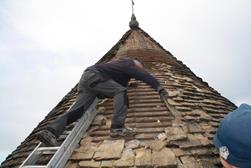 The Round Church or Holy Sepulchre, as it should be called, is a famous Cambridge church, renowned for its antiquity, visual appeal and unusual circular form. Dating from around 1130, the Round Church is one of the oldest buildings in Cambridge and is modeled on the 4th century Church of the Holy Sepulchre in Jerusalem built by the Roman Emperor Constantine.
The Round Church or Holy Sepulchre, as it should be called, is a famous Cambridge church, renowned for its antiquity, visual appeal and unusual circular form. Dating from around 1130, the Round Church is one of the oldest buildings in Cambridge and is modeled on the 4th century Church of the Holy Sepulchre in Jerusalem built by the Roman Emperor Constantine.
Image, left: Stripping the damaged slates from the upper spire
The Round Church was founded by the Norman fraternity of the Holy Sepulchre, who came to Britain with William the Conqueror. Impressed by the round style of the early Romanesque churches they saw in the Holy Land during the first crusade in 1097, the Normans brought the design to Europe and even as far as Cambridge. The Cambridge Round church is now just one of four surviving mediaeval round churches of this antiquity in Britain.
Following substantial additions, especially a heavy 15th century tower, which subsequently threatened to collapse, the church was extensively restored to its earlier Romanesque style in the 19th century. Central to the original form is the conical roof with its beautiful stone ‘slates’, whose slight irregular texture and colour enhances the attractive picturesque look of the building.
.jpg?h=168&w=251&la=en) Today, the slating of a roof generally implies the use of grey Welsh slates, which became prevalent in the 19th century, once they could easily be transported around the country by boat, train and lorry. However, in earlier times the cost of transporting stone building materials was so high that any appropriate local stone was used. The nearest ‘slates’ to Cambridge were not slates in the true geological sense but platy limestones, which could be split into slabs thin enough to be used on a roof.
Today, the slating of a roof generally implies the use of grey Welsh slates, which became prevalent in the 19th century, once they could easily be transported around the country by boat, train and lorry. However, in earlier times the cost of transporting stone building materials was so high that any appropriate local stone was used. The nearest ‘slates’ to Cambridge were not slates in the true geological sense but platy limestones, which could be split into slabs thin enough to be used on a roof.
Image, right: Replacement of upper spire showing reclaimed slates nailed in place.
In Early Mediaeval times, the nearest building and roofing stones had to be brought from limestone quarries in the Jurassic age hills of Oxfordshire, Lincolnshire and Northamptonshire. Barnack stone from Northamptonshire was used to build Peterborough cathedral (from A.D. 664) and subsequently became the main material for the construction of the abbeys and cathedrals of East Anglia, such as Ely Cathedral (1174-89), early Cambridge colleges, such as Corpus Christi and the Round Church.
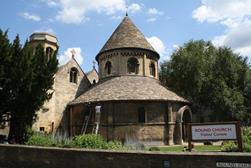 Image left: A little bit of Jerusalem in Cambridge – the Round Church with upper and lower roofs restored by specialist heritage roofers Claude N Smith Ltd
Image left: A little bit of Jerusalem in Cambridge – the Round Church with upper and lower roofs restored by specialist heritage roofers Claude N Smith Ltd
But the roof of the Round Church, required the use of Collyweston Slate from near Stamford in Lincolnshire. Collyweston slate has been quarried since Roman times and then was mined, once the surface outcrops of the rock became worked out and the quarrymen followed the seams of strata underground. Despite the extra cost and risk involved, Collyweston limestone can be split into remarkably thin ‘slaty’ sheets that are only around 10 mm thick and are ideal for roofing.
The Collyweston limestone is particular in that its platiness is not immediately obvious. The limestone is extracted in blocks, which have to be matured and split by natural weathering processes. The large and relatively thick slabs are left outside and exposed to overwinter freezing and thawing. The development and expansion of ice crystals along certain bedding planes splits it into thin slabs, ideal for use as roofing ‘slates’.
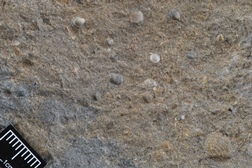 However, even Collyweston slate does not last forever and after a few centuries, exposed to our grimy and corrosive atmosphere, some of the slate deteriorates and needs to be replaced. Lack of new supply of Collyweston slate and the high costs of working it have resulted in the replacement of Collyweston slate by the nearest equivalent limestone slate, which has the same visual appeal.
However, even Collyweston slate does not last forever and after a few centuries, exposed to our grimy and corrosive atmosphere, some of the slate deteriorates and needs to be replaced. Lack of new supply of Collyweston slate and the high costs of working it have resulted in the replacement of Collyweston slate by the nearest equivalent limestone slate, which has the same visual appeal.
Image right: Closeup showing numerous small bivalves, Collyweston
In the 1960s, the Collyweston slates of the Cambridge Round Church were replaced by Stonesfield ‘slate’. This is another Jurassic limestone of considerable geological interest, which originally had to be extracted from pits and underground workings. Stonesfield ‘slate’ was the source of many historically important fossils, including some of the first dinosaur remains and oldest mammal fossils. But the modern Stonesfield slate is slightly different and is now extracted from opencast quarries.
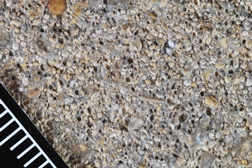 The modern Stonesfield ‘slate’ is over twice as thick as the Collyweston slate, which makes the roof much heavier but still produces the same visual effect. The present repair and restoration of the Round Church roof has required the replacement of more than 80% of the Stonesfield slates from the 1960s with reclaimed Stonesfield slates. The work has been carried out by a firm of specialist roofers, which ironically is still based in Collyweston, near Stamford in Lincolnshire.
The modern Stonesfield ‘slate’ is over twice as thick as the Collyweston slate, which makes the roof much heavier but still produces the same visual effect. The present repair and restoration of the Round Church roof has required the replacement of more than 80% of the Stonesfield slates from the 1960s with reclaimed Stonesfield slates. The work has been carried out by a firm of specialist roofers, which ironically is still based in Collyweston, near Stamford in Lincolnshire.
Image left: Closeup showing abundant oolitic grains with white microporous outer layers and a few shell fragments, Stonesfield
There are samples of both Stonesfield and Collyweston ‘slates’ in the historic Watson Collection of Building Stones in the Department of Earth Science in the University of Cambridge. Although these are single samples, they demonstrate the differences between the two flaggy limestones. The Collyweston ‘slate’ is remarkably flat, even-bedded and highly fossiliferous with an abundance of thinly shelled bivalves on some bedding planes, mostly single valves of juvenile scallops just a few millimetres in size. When freshly quarried the rock is grey and weathers to a yellow-brown, indicating the presence of iron minerals which are oxidized by weathering. However, this weathering makes little or no apparent difference to the fissility of the rock. The sediment contains both pellets and detrital mica and it is probably the latter, along with the flat bivalve shells which aids the fissility of the limestone.
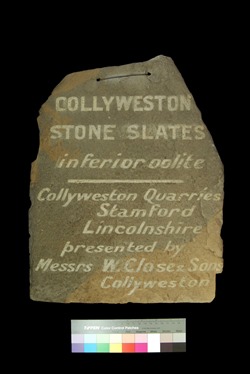 By contrast the Stonesfield ‘slate’ breaks into thicker slabs that have more irregular planar bedding and parting planes. The grain size of the Stonefield slate is coarser than that of the Collyweston slate. And whilst numerous small bivalves can be seen scattered across the bedding planes, it is the abundance of white ooids (just under a millimetre in size) on certain bedding planes, which seems to influence the fissility of the rock, as no detrital mica is present. The white colour of the ooids is characteristic of microporous grains, which increase the ability of this rock to absorb water. This could be the reason why blocks of the limestone split readily after overwintering on the ground surface due to a repeated freeze-thaw process.
By contrast the Stonesfield ‘slate’ breaks into thicker slabs that have more irregular planar bedding and parting planes. The grain size of the Stonefield slate is coarser than that of the Collyweston slate. And whilst numerous small bivalves can be seen scattered across the bedding planes, it is the abundance of white ooids (just under a millimetre in size) on certain bedding planes, which seems to influence the fissility of the rock, as no detrital mica is present. The white colour of the ooids is characteristic of microporous grains, which increase the ability of this rock to absorb water. This could be the reason why blocks of the limestone split readily after overwintering on the ground surface due to a repeated freeze-thaw process.
Image right: Collyweston slate in the Watson Collection, Department of Earth Sciences, University of Cambridge.
*Douglas Palmer, Communications Officer, Sedgwick Museum, Cambridge
Sources
www.christianheritage.org.uk/Groups/91893/Home/Round_Church/Church_Building/Church_Building.aspx
www.claudesmith.co.uk
www.collywestonstoneslaterstrust.org.uk/whatiscollywestonslate.htm
Cambridge Geology Trail, 31p, published by and obtainable from the Sedgwick Museum, Cambridge: www.sedgwickmuseum.org
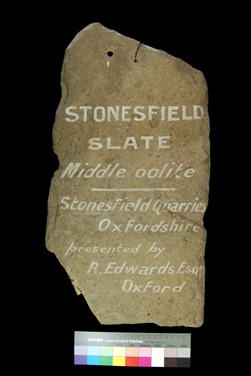 Acknowledgments
Acknowledgments
Several people in the Department of Earth Science, University of Cambridge have helped with aspects of this article including Dr Tony Dickson, Dr Liz Harper, Dr Nigel Woodcock, Ricardo Paredes, Matt Riley as well as Nigel Smith of Claude N Smith Ltd, who kindly supplied the photos of the restoration of the Round Church roof.